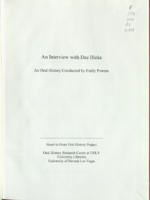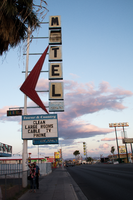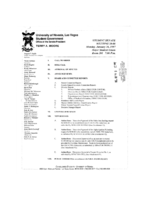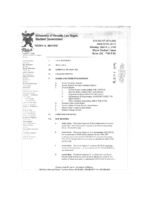Search the Special Collections and Archives Portal
Search Results

Transcript of interview with Dee Hicks by Claytee D. White, May 4, 2008
Date
Archival Collection
Description
Text

J. K. Russ oral history interview: transcript
Date
Archival Collection
Description
Oral history interview with J. K. Russ conducted by Claytee D. White on December 22, 2017 for the Remembering 1 October Oral History Project. In this interview, Russ discusses her early life in New Zealand and growing up on a tobacco farm. She remembers arriving to the United States and establishing a career as an artist. Russ talks about the 1 October shooting, creating an art exhibit using cards and letters received from people all over the world, and Las Vegas’ response to the tragedy. Lastly, Russ describes the art community in Las Vegas and the Arts District.
Text

Transcript of interview with D. Taylor by Claytee White, July 25, 2014
Date
Archival Collection
Description
D. Taylor knew from the time he graduated Georgetown University he wanted to make his career in the labor movement. He credits his Virginia-born mother as an early mentor; she was at once “nice,” “tough,” “genteel,” and “liberal,” and she instilled these values in her son. As a new college grad, Taylor headed west to Lake Tahoe, where he was hired in 1981 by the Culinary Union to organize workers and oversee an eleven-and-a-half-month strike. Culinary then sent him to organize Las Vegas in 1984, a few years after Ronald Reagan crushed the 1981 Professional Air Traffic Controllers Organization strike and only months after the Amalgamated Transit Union strike against Greyhound went down in defeat. In this interview, Taylor recalls that in 1984, most Las Vegas casinos were no longer owned by individuals and families but by multinational corporations that refused to negotiate improved health insurance coverage for their workers. Taylor led a citywide strike that ultimately cost the union six casinos and about eight thousand members. In 1987, Culinary sent him back to Las Vegas, where he has remained. He tells the history of the union in Las Vegas and its leadership, especially crediting Al Bramlet in the 1970s for recruiting a diverse workforce and promoting casino hiring through the union. In 1987 Taylor changed the union rep structure to give a larger voice to Las Vegas’s racially diverse workforce and began recruiting potential leaders of color (like Hattie Canty)—thus, he followed Bramlet’s lead but pushed it further to create a truly bottom-up organization. The husband and father is especially proud of the various programs Culinary Workers Union Local 226 has implemented to improve the lives of Las Vegas union workers and their families but sees widening gaps in the city between those who have great wealth and those who do not. To Taylor, his work is “always about the members. They endure so much. They sacrifice so much.”
Text

Photographs of Towne and Country Motel sign, Las Vegas (Nev.), April, 18, 2017
Date
Archival Collection
Description
Site address: 2033 Fremont St
Sign owner: Huang Hsiu Ping
Sign details: Sold in 2009 for $1 millon. It a .66 acre lot with an original construction year of 1958, with additions in 2000 and 2007.
Sign condition: 2 - O Panel knocked out, broken lexan covering the Pool wording of neon, heavy discoloration of the letter T and the E is almost completely worn off. Sun damage in the paint, otherwise looks functional.
Sign form: Back to Back Pole Sign
Sign-specific description: Pole sign that is double sided, Motel reading on either side with flag like components hanging off the support pole, each letter with its own component. A giant red check-mark shaped arrow in the center of the sign grabs the visitor's attention with its bright vibrant red color and its neon tubing filling it its shape, used as a directional tool into the parking lot. Underneath the arrow is a tiny reader board with cutout letters listing the amenities available in each of the rooms. Underneath the reader board is a little component that spells Pool with neon outlining the letters. The color scheme ranges from pale baby blue for the framework of the letters and reader board, and the bright red of the arrow.
Sign - type of display: Neon, internally lit "Motel" letters, and reader board
Sign - media: Steel and Plastic
Sign environment: Surrounded by other motels and hotels, and near a residential area
Survey - research locations: Motel website, and conversation with owner
Survey - research notes: Owners seemed aggravated by survey
Survey - other remarks: Open from 8 am to 4 pm, they close on Mondays entirely
Surveyor: Danny Jacobs
Survey - date completed: 2017-08-12
Sign keywords: Neon; Steel; Plastic; Reader board; Pole sign; Back to back; Internally illuminated
Mixed Content
Donn Arden Photographs
Identifier
Abstract
The Donn Arden Photographs (approximately 1920-1989) contain photographs, negatives, and photographic slides of dancer and choreographer Donn Arden. The photographs primarily document Arden's life as a dancer and choreographer in Las Vegas, Nevada and in Paris, France, including performances at the Stardust Hotel, Desert Inn, and MGM Grand in Las Vegas and the Lido in Paris. The photographs also depict rehearsals, dancers, showgirls, Arden's friends and family, and performance locations.
Archival Collection
Clinton Wright Photographs
Identifier
Abstract
The Clinton Wright Photographs (1964-2018) contains black-and-white photographic negatives of various sizes, dating from 1964 to 1971. The images document the Black experience in Las Vegas, Nevada during the 1960s and 1970s, and capture scenes of everyday life in the historic Black neighborhood known as the Westside, social events such as weddings and parties, and events hosted by local churches. The collection also contains a photograph of Clinton Wright from 2017 when he visited the University of Nevada, Las Vegas Special Collections and Archives, and a memorial program for his wife, Joyce Wright, who passed away in 2018.
Archival Collection

Meeting minutes for Consolidated Student Senate University of Nevada, Las Vegas, January 26, 1998
Date
Archival Collection
Description
Text

Meeting minutes for Consolidated Student Senate University of Nevada, Las Vegas, March 2, 1998
Date
Archival Collection
Description
Text

Meeting minutes for Consolidated Student Senate, University of Nevada, Las Vegas, April 03, 1979
Date
Archival Collection
Description
Text

